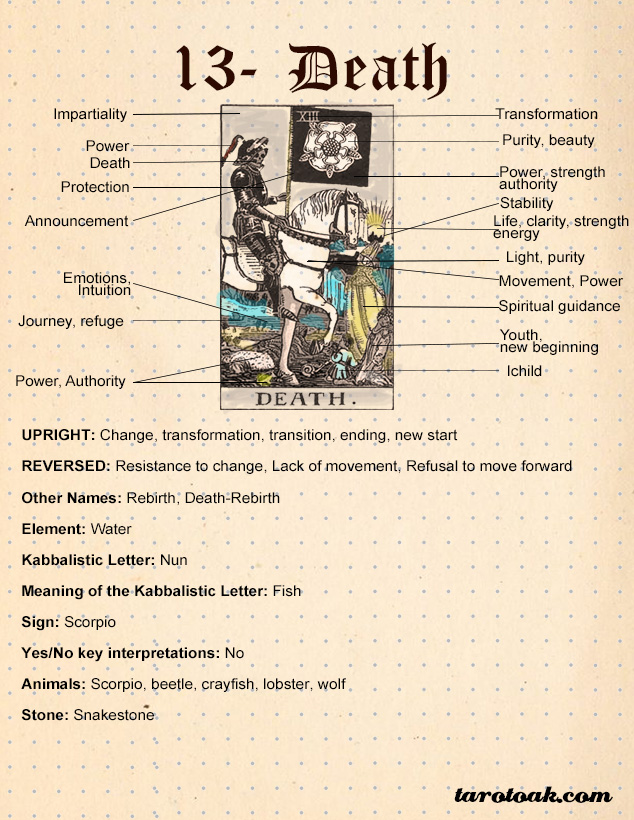The Death card in tarot, often adorned with striking imagery and traditional motifs, is universally perceived with a sense of trepidation. Yet, this card transcends the superficial connotation of finality; it heralds transformation, renewal, and an invitation to embrace change. In the world of tarot, the Death card stands as a profound symbol, impelling us to shed our old skins and embark on new journeys of self-discovery.
To comprehend the essence of the Death card, one must first dismantle the anxiety that often accompanies its appearance. The card’s primary message is not about literal death; rather, it symbolizes the end of a significant phase in life and the dawning of a new one. Often depicted as the Grim Reaper, it evokes a visceral reaction. However, it is crucial to understand that this figure embodies not destruction, but rather the cyclical nature of existence.
As the wheel of life spins, the Death card encourages us to confront what no longer serves us. This could be an outdated personal belief, a toxic relationship, or an unfulfilling career. By allowing these elements to dissolve, we create space for fresh experiences to emerge. The key takeaway is the promise of rebirth: an assurance that with every ending comes a new beginning, reminiscent of the phoenix rising from its ashes.
Archetypically, the Death card is associated with the sign of Scorpio, a symbol resonating with renewal and intensity. Scorpios are known for their tenacity and transformative qualities, often delving deep into emotions and experiences. Thus, when the Death card surfaces in a reading, it can signify profound emotional shifts or a pressing need to confront buried feelings. This connection amplifies the card’s significance, serving as a reminder of the necessity of emotional catharsis in the journey toward personal growth.
Moreover, the Death card serves as a narrative that weaves through various aspects of life, including relationships, career, and personal evolution. In relationships, the card can signify the end of a chapter, possibly calling for a resolution of lingering tensions or a commitment to move forward. It invites introspection: what patterns are diminishing the vibrancy of your interactions? Recognizing these patterns can catalyze the metamorphosis needed to foster healthier dynamics.
In a career context, the Death card embodies the courage to re-evaluate one’s professional trajectory. Are your aspirations aligned with your current path? This card can represent the longing for change, hinting at the potential for finding a vocation that more authentically resonates with your passions. Inherent in this message is the encouragement to let go of complacency, embarking on ventures that inspire creativeness and fulfillment.
Beyond the realm of personal relationships and careers, the Death card prompts us to confront our inner selves, exploring the shadows that shape our identities. It serves as a powerful testament to the importance of self-reflection. Acknowledge your fears; delve into the recesses of your psyche. By illuminating the dark corners of your mind, you can emerge into a place of empowerment and clarity.
This card encourages individuals to adopt a mindset of curiosity amid upheaval. When the familiar crumbles, it can ignite a sense of adventure. The question, then, becomes: what new possibilities can you forge in the wake of transformation? The Death card cultivates resilience, urging us to embrace the unknown and find beauty in the delicate dance of mortality and rebirth.
Furthermore, it is important to recognize that the Death card, while often interpreted in a solitary lens, has important communal implications. As we navigate transitions, we may find solace and support among those who share similar experiences. Whether it be through friendships, family, or community groups, it is essential to seek out connections that foster collective healing. Together, we can redefine what it means to transition, celebrating both personal and communal transformations.
In conclusion, the Death card, despite its daunting portrayal, invites us to reimagine our perspectives on endings and transitions. It pushes against the fear of the unknown, encouraging us to embrace change with open arms. Each new beginning, however daunting, signifies growth. Rather than seeing an end as the conclusion of a narrative, envision it as a new chapter waiting to unfold. The Death card is a promise of metamorphosis, a beckoning to rise afresh from the ashes of what once was, and to boldly step into the boundless possibilities that lie ahead. By shifting our paradigms, we cultivate a fertile ground for evolution, adaptation, and ultimately, enlightenment.









Leave a Comment